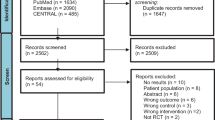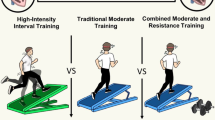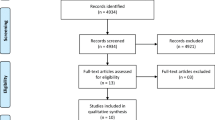Abstract
Background
Exercise-based cardiac rehabilitation has positive benefits for patients with chronic heart failure (CHF), but the choice of exercise intensity has been controversial. The aim of this systematic review and meta-analysis was to investigate the effects of different exercise intensities on cardiopulmonary function and quality of life (QoL) of patients with CHF.
Methods
Randomized controlled trials (RCTs) of different exercise intensities applied to patients with CHF were searched in PubMed, Web of Science, the Cochrane Library, and Embase databases from inception to December 2021. Study selection and data extraction were performed simultaneously by two independent reviewers, using the Physiotherapy Evidence Database Scale (PEDro) for quality assessment of the included literature. The weighted mean differences (WMD) or standardized mean difference (SMD) were calculated by employing a fixed or random effects model. Other statistical analyses included subgroup analysis and sensitivity analysis. Quality of evidence was evaluated by the Grade of Recommendation, Assessment, Development, and Evaluation (GRADE) method.
Results
Eight RCTs were included. Analyses reported no significant improvement in left ventricular ejection fractions (LVEF; WMD = 0.47, 95% CI [−4.10, 5.03], p = 0.841), peak oxygen uptake (peak VO2) (SMD = 0.38, 95% CI [−0.03, 0.80], p = 0.069) and 6‑min walking distance (6MWD) (WMD = 14.10, 95% CI [−9.51, 37.72], p = 0.242). Exercise interventions of varying intensity produced small-to-moderate beneficial effects on QoL (WMD = −4.99, 95% CI [−8.29, −1.68], p = 0.003), which appeared to be attenuated at long-term follow-up (WMD = 2.12, 95% CI [−2.91, 7.16], p = 0.409).
Conclusion
High-intensity exercise does not have a significant advantage over moderate-intensity exercise in improving cardiopulmonary function and aerobic capacity in patients with CHF. Beneficial changes in QoL from high-intensity exercise also appeared to decrease during long-term follow-up, indicating a cumulative effect of the efficacy of high-intensity exercise.
Zusammenfassung
Hintergrund
Trainingsbasierte kardiale Rehabilitation hat positive Auswirkungen auf Patienten mit chronischer Herzinsuffizienz (CHF), aber die Auswahl der Trainingsintensität ist umstritten. Ziel der vorliegenden systematischen Übersicht und Metaanalyse war es, die Auswirkungen verschiedener Trainingsintensitäten auf die Herz-Lungen-Funktion und Lebensqualität (QoL) bei Patienten mit CHF zu untersuchen.
Methoden
Randomisierte kontrollierte Studien (RCT) zu unterschiedlichen Trainingsintensitäten bei Patienten mit CHF wurden in den Datenbanken PubMed, Web of Science, der Cochrane Library und Embase von Beginn bis Dezember 2021 gesucht. Die Studienauswahl und Datenextraktion erfolgten gleichzeitig durch 2 unabhängige Untersucher unter Verwendung der Physiotherapy Evidence Database Scale (PEDro) für die Qualitätsbeurteilung der einbezogenen Literatur. Die gewichteten mittleren Differenzen (WMD) oder standardisierten mittleren Differenzen (SMD) wurden unter Einsatz eines Fixed- oder Random-Effects-Modells berechnet. Zu den weiteren statistischen Analysen gehörten die Subgruppen- und die Sensitivitätsanalyse. Die Qualität der Evidenz wurde anhand der GRADE-Methode (Grade of Recommendation, Assessment, Development, and Evaluation) beurteilt.
Ergebnisse
In die Analyse wurden 8 RCT eingeschlossen. Die Auswertung ergab keine signifikante Verbesserung bei der linksventrikulären Ejektionsfraktion (LVEF; WMD = 0,47, 95 %-Konfidenzintervall, 95 %-KI: −4,10; 5,03; p = 0,841), dem Spitzenwert der Sauerstoffaufnahme (PeakVO2; SMD = 0,38; 95 %-KI:−0,03; 0,80; p = 0,069) und der 6‑min-Gehstrecke (6MWD; WMD = 14,10; 95 %-KI:−9,51; 37,72; p = 0,242). Trainingsinterventionen verschiedener Intensität führten zu geringen bis mittleren positiven Auswirkungen auf die QoL (WMD = −4,99; 95 %-KI:−8,29; −1,68; p = 0,003), die sich jedoch bei der Langzeitnachbeobachtung abzuschwächen schienen (WMD = 2,12; 95 %-KI:−2,91; 7,16; p = 0,409).
Schlussfolgerung
Training hoher Intensität bringt keinen deutlichen Vorteil gegenüber Training mittlerer Intensität in Bezug auf die Verbesserung der Herz-Lungen-Funktion und der aeroben Kapazität bei Patienten mit CHF. Positive Veränderungen der QoL durch Training hoher Intensität schienen auch während der Langzeitnachbeobachtung abzunehmen, was auf einen kumulativen Effekt der Wirksamkeit von Training hoher Intensität hinweist.





Similar content being viewed by others
References
McDonagh TA et al (2021) 2021 ESC Guidelines for the diagnosis and treatment of acute and chronic heart failure. Eur Heart J 42(36):3599–3726
Pezel T et al (2021) Diagnosis and treatment of iron deficiency in heart failure: OFICSel study by the French heart failure working group. ESC Heart Fail 8(2):1509–1521
Savarese G et al (2023) Global burden of heart failure: a comprehensive and updated review of epidemiology. Cardiovasc Res 118(17):3272–3287
Taylor RS et al (2018) Impact of exercise-based cardiac rehabilitation in patients with heart failure (ExTraMATCH II) on mortality and hospitalisation: an individual patient data meta-analysis of randomised trials. Eur J Heart Fail 20(12):1735–1743
Seferovic PM et al (2019) Clinical practice update on heart failure 2019: pharmacotherapy, procedures, devices and patient management. An expert consensus meeting report of the Heart Failure Association of the European Society of Cardiology. Eur J Heart Fail 21(10):1169–1186
Wisløff U et al (2007) Superior cardiovascular effect of aerobic interval training versus moderate continuous training in heart failure patients: a randomized study. Circulation 115(24):3086–3094
Rohmansyah NA et al (2023) High-intensity interval training versus moderate-intensity continuous training for improving physical health in elderly women. Inquiry 60:469580231172870
Conraads VM et al (2015) Aerobic interval training and continuous training equally improve aerobic exercise capacity in patients with coronary artery disease: the SAINTEX-CAD study. Int J Cardiol 179:203–210
Kim C, Choi HE, Lim MH (2015) Effect of high interval training in acute myocardial infarction patients with drug-eluting stent. Am J Phys Med Rehabil 94(10 Suppl 1):879–886
Molmen-Hansen HE et al (2012) Aerobic interval training reduces blood pressure and improves myocardial function in hypertensive patients. Eur J Prev Cardiol 19(2):151–160
Pelliccia A et al (2021) 2020 ESC Guidelines on sports cardiology and exercise in patients with cardiovascular disease. Eur Heart J 42(1):17–96
Moseley AM et al (2020) Using research to guide practice: the Physiotherapy Evidence Database (PEDro). Braz J Phys Ther 24(5):384–391
Hozo SP, Djulbegovic B, Hozo I (2005) Estimating the mean and variance from the median, range, and the size of a sample. BMC Med Res Methodol 5:13
Cumpston M et al (2019) Updated guidance for trusted systematic reviews: a new edition of the Cochrane Handbook for Systematic Reviews of Interventions. Cochrane Database Syst Rev. https://doi.org/10.1002/14651858.ED000142
Guyatt GH et al (2008) GRADE: an emerging consensus on rating quality of evidence and strength of recommendations. BMJ 336(7650):924–926
Besnier F et al (2019) Short-term effects of a 3-week interval training program on heart rate variability in chronic heart failure. A randomised controlled trial. Ann Phys Rehabil Med 62(5):321–328
Donelli da Silveira A et al (2020) High-intensity interval training is effective and superior to moderate continuous training in patients with heart failure with preserved ejection fraction: A randomized clinical trial. Eur J Prev Cardiol 27(16):1733–1743
Koufaki P et al (2014) Low-volume high-intensity interval training vs continuous aerobic cycling in patients with chronic heart failure: a pragmatic randomised clinical trial of feasibility and effectiveness. J Rehabil Med 46(4):348–356
Ellingsen Ø et al (2017) High-intensity interval training in patients with heart failure with reduced ejection fraction. Circulation 135(9):839–849
Angadi SS et al (2015) High-intensity interval training vs. moderate-intensity continuous exercise training in heart failure with preserved ejection fraction: a pilot study. J Appl Physiol 119(6):753–758
Bobenko A et al (2018) Amount or intensity? Potential targets of exercise interventions in patients with heart failure with preserved ejection fraction. ESC Heart Fail 5(1):53–62
Papathanasiou J et al (2017) The effect of group-based cardiac rehabilitation models on the quality of life and exercise capacity of patients with chronic heart failure. Hellenic J Cardiol 58(6):432–435
Luo Q et al (2020) Establishment of exercise intensity for patients with chronic heart failure equivalent to anaerobic threshold based on 6‑minute walking test. Ann Palliat Med 9(5):2766–2775
Ismail H et al (2013) Clinical outcomes and cardiovascular responses to different exercise training intensities in patients with heart failure: a systematic review and meta-analysis. JACC Heart Fail 1(6):514–522
Fu TC et al (2016) Aerobic interval training elicits different hemodynamic adaptations between heart failure patients with preserved and reduced ejection fraction. Am J Phys Med Rehabil 95(1):15–27
Boulmpou A et al (2022) Effects of different exercise programs on the cardiorespiratory reserve in HFpEF patients: a systematic review and meta-analysis. Hellenic J Cardiol 64:58–66
Hesketh K et al (2021) Home-based HIIT and traditional MICT prescriptions improve cardiorespiratory fitness to a similar extent within an exercise referral scheme for at-risk individuals. Front Physiol 12:750283
Tucker WJ et al (2019) meta-analysis of exercise training on left ventricular ejection fraction in heart failure with reduced ejection fraction: a 10-year update. Prog Cardiovasc Dis 62(2):163–171
Hambrecht R et al (2000) Effects of exercise training on left ventricular function and peripheral resistance in patients with chronic heart failure: A randomized trial. JAMA 283(23):3095–3101
Taylor RS et al (2019) Impact of exercise rehabilitation on exercise capacity and quality-of-life in heart failure: individual participant meta-analysis. J Am Coll Cardiol 73(12):1430–1443
Dun Y et al (2019) High-intensity interval training in cardiac rehabilitation. Clin Geriatr Med 35(4):469–487
Funding
There is no funding to report.
Author information
Authors and Affiliations
Contributions
Conceptualization, Yan Bai and Fengying Wang; methodology, Fengying Wang; software, Fengying Wang and Wenqin Zhou; data curation, Yan Bai and Fengying Wang; writing-original draft preparation, Xiaoyan Wang; writing-review and editing, Xiaoyan Wang and Bin Hua. All authors have read and agreed to the published version of the manuscript.
Corresponding author
Ethics declarations
Conflict of interest
F. Wang, Y. Bai, B. Hua, W. Zhou and X. Wang declare that they have no competing interests.
For this article no studies with human participants or animals were performed by any of the authors. All studies mentioned were in accordance with the ethical standards indicated in each case.
Additional information
The authors Fengying Wang and Yan Bai contributed equally to this work.
Data Availability Statement
The raw data supporting the conclusions of this article will be made available by the authors, without undue reservation.
Appendix
Appendix
Rights and permissions
About this article
Cite this article
Wang, F., Bai, Y., Hua, B. et al. Effect of different intensity exercises on cardiopulmonary function and quality of life of patients with chronic heart failure. Herz 49, 134–146 (2024). https://doi.org/10.1007/s00059-023-05202-5
Received:
Revised:
Accepted:
Published:
Issue Date:
DOI: https://doi.org/10.1007/s00059-023-05202-5








